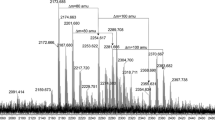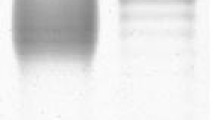Abstract
The lipopolysaccharides of Rhodobacter sulfidophilus and the two budding species Rhodopseudomonas acidophila and Rhodopseudomonas blastica were isolated and chemically analyzed. The all have a lipid A backbone structure with glucosamine as the only amino sugar. The lipid A's of Rb. sulfidophilus and Rps. blastica contain phosphate, their fatty acids are characterized by ester-linked, unsubstituted 3-OH-10:0 and amide-linked 3-OH-14:0 (Rb. sulfidophilus) or 3-oxo-14:0 (Rps. blastica). Lipid A of Rps. acidophila is free of phosphate and contains the rare 3-OH-16:0 fatty acid in amide linkage.
The lipopolysaccharides of all three species contain 2-keto-3-deoxy-octonate (KDO) but are devoid of heptoses. Neutral sugars with the exception of glucose are lacking in the lipopolysaccharide of Rb. sulfidophilus. This shows a high galacturonic acid content. The lipopolysaccharides of Rps. acidophila and Rps. blastica have neutral sugar spectra indicative for typical O-chains (rhamnose, mannose, galactose, glucose in both species, and in Rps. blastica additionally 2-O-methyl-6-deoxy-hexose). The taxonomic value of the data is discussed.
Similar content being viewed by others
References
Ahamed NM, Mayer, H, Biebl, H, Weckesser J (1982) Lipopolysaccharide with 2,3-diamino-2,3-dideoxyglucose containing lipid A in Rhodopseudomonas sulfoviridis. FEMS Microbiol Lett 14:27–30
Ambler, RP, Meyer TE, Kamen MD (1979) Anomalies in amino acid sequences of small cytochromes c and cytochromes c′ from two species of purple photosynthetic bacteria. Nature (Lond) 278:661–662
Bligh EG, Dyer WJ (1959) A rapid method of total lipid extraction and purification. Can J Biochem Physiol 37:911–917
Dickerson RE (1980) Evolution and gene transfer in purple photosynthetic bacteria. Nature (Lond) 283:210–212
Drews G (1965) Die Isolierung schwefelfreier Purpurbakterien. Zbl Bak I Abt Orig Suppl Heft, 1:170–178
Eckersly K, Dow CS (1980) Rhodopseudomonas blastica sp. nov.: a member of the Rhodospirillaceae. J Gen Microbiol 119:465–473
Galambos JT (1967) The reaction of carbazole with carbohydrates. Anal Biochem 19:119–132
Galanos C, Lüderitz O, Westphal O (1969) A new method for the extraction of R-lipopolysaccharide. Eur J Biochem 9:245–249
Gibson J, Stackebrandt E, Zablen LB, Gupta R, Woese CR (1979) A phylogenetic analysis of the purple photosynthetic bacteria. Curr Microbiol 3:59–64
Hansen TA, Veldkamp H (1973) Rhodopseudomonas sulfidophila, nov. spec., a new species of the purple nonsulfur bacteria. Arch Microbiol 92:45–48
Holst O, Borowiak D, Weckesser J, Mayer H (1983) Structural studies on the phosphate-free lipid A of Rhodomicrobium vannielii ATCC 17100. Eur J Biochem 137:325–332
Imhoff JF (1982) Occurrence and evolutionary significance of two sulfate assimilation pathways in the Rhodospirillaceae. Arch Microbiol 132:197–203
Imhoff JF (1984) Quinones of phototrophic purple bacteria. FEMS Microbiol Lett 25:85–89
Imhoff JF, Trüper HG, Pfennig N (1984) Rearrangement of the species and genera of the phototrophic “purple nonsulfur bacteria”. Int J Systematic Bacteriol 34:340–343
Kates M (1972) Techniques of lipodology: isolation analysis and identification of lipids. North-Holland, Amsterdam, p 515.
Lowry OH, Roberts NR, Leiner KY, Wu ML, Farr AL (1954) The quantitative histochemistry of brain. I. Chemical methods. J Biol Chem 207:1–17
Mayer H, Bock E, Weckesser J (1983) 2,3-Diamino-2,3-dideoxyglucose containing lipid A in Nitrobacter X14. FEMS Microbiol Lett 17:93–96
Mayer H, Weckesser J (1984) Unusual lipid A's: structures, taxonomical relevance and potential value for endotoxin research. In: Rietschel ET (ed) Handbook of endotoxin, vol 1: Chemistry of endotoxin. Elsevier BV, New York, pp 221–247
Omar AS, Flammann H, Borowiak D, Weckesser J (1983) Lipopolysaccharide of two strains of the phototrophic bacterium Rhodopseudomonas capsulata. Arch Microbiol 134:212–216
Partridge SM (1948) Filter-paper partition chromatography of sugars. 1. General description and application to the qualitative analysis of sugars in apples, egg white and foetal blood of sheep. Biochem J 42:238–250
Pfennig N (1969) Rhodopseudomonas acidophila, sp.n.,a new species of the budding purple nonsulfur bacteria. J Bacteriol 99:597–602
Pfennig N (1977) Phototrophic green and purple bacteria: a comparative systematic survey. Ann Rev Microbiol 31:275–290
Pfennig N, Trüper HG (1983) Taxonomy of phototrophic green and purple bacteria: a review. Ann Microbiol (Inst Pasteur) 134B:9–20
Rietschel ET, Gottert H, Lüderitz O, Westphal O (1972) Nature and linkages of the fatty acids present in the lipid A component of Salmonella lipopolysaccharide. Eur J Biochem 28:166–173
Roppel J, Mayer H, Weckesser J (1975) Identification of 2,3-diamino-2,3-dideoxy-hexose in the lipid A component of lipopolysaccharides of Rhodopseudomonas viridis and Rhodopseudomonas palustris. Carbohydr Res 40:31–40
Salimath VP, Tharanathan RN, Weckesser J, Mayer H (1984) The structure of the polysaccharide moiety of Rhodopseudomonas sphaeroides ATCC 17023 lipopolysaccharide. Eur J Biochem 144:227–232
Seewaldt W, Schleifer KH, Bock E, Stackebrandt E (1982) The close phylogenetical relationship of Nitrobacter and Rhodopseudomonas palustris. Arch Microbiol 131:287–290
Snyder R, Stephens N (1959) A simplified spectrophotometric determination of ester groups in lipids. Biochim Biophys Acta 34:244–245
Strittmatter W, Weckesser J, Salimath PV, Galanos C (1983) Nontoxic lipopolysaccharide from Rhodopseudomonas sphaeroides ATCC 17023. J Bacteriol 155:153–158
Weckesser J, Drews G, Fromme I (1972) Chemical analysis of and degradation studies on the cell wall lipopolysaccharide of Rhodopseudomonas capsulata. J Bacteriol 109:1106–1113
Weckesser J, Drews G, Mayer H (1979) Lipopolysaccharides of photosynthetic bacteria. Ann Rev Microbiol 33:215–239
Westphal O, Lüderitz O, Bister E (1952) Über die Extraktion von Bakterien mit Phenol/Wasser. Z Naturforsch 7b:148–155
Wollenweber HW, Broady KW, Lüderitz O, Rietschel ET (1982) The chemical structure of lipid A. Demonstration of amidelinked 3-acyloxyacyl-residues in Salmonella minnesota Re lipopolysaccharide. Eur J Biochem 124:191–198
Author information
Authors and Affiliations
Additional information
This paper is dedicated to Prof. Dr. Norbert Pfennig on the occasion of his 60th birthday
Rights and permissions
About this article
Cite this article
Tegtmeyer, B., Weckesser, J., Mayer, H. et al. Chemical composition of the lipopolysaccharides of Rhodobacter sulfidophilus, Rhodopseudomonas acidophila, and Rhodopseudomonas blastica . Arch. Microbiol. 143, 32–36 (1985). https://doi.org/10.1007/BF00414764
Received:
Accepted:
Issue Date:
DOI: https://doi.org/10.1007/BF00414764




